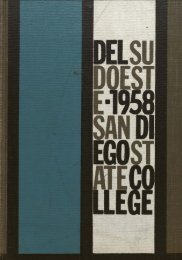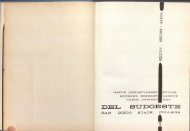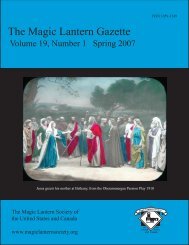The Magic Lantern Gazette - Library
The Magic Lantern Gazette - Library
The Magic Lantern Gazette - Library
You also want an ePaper? Increase the reach of your titles
YUMPU automatically turns print PDFs into web optimized ePapers that Google loves.
Early <strong>Magic</strong> <strong>Lantern</strong>s 11<br />
have produced projection-clocks already around 1676. 12<br />
It is hard to imagine that this astonishing piece would ever<br />
have been used for practical purposes, save perhaps for demonstrations.<br />
To be able to project the images, one has to open<br />
a painted cap on the front side and insert a lens tube. To<br />
switch between the lantern slides and the clock face, further<br />
adjustments may be needed. Unfortunately, it was impossible<br />
to find out more about the internal workings, because the object<br />
was closed. On the front side the device has a landscape<br />
painting with mythological (?) figures and a (non-functional?)<br />
clock face, which enhances its value as a prestigious display<br />
object. Very likely this was a showpiece meant to appeal to<br />
“princely taste”. Surprisingly, it seems to be missing from the<br />
literature on the magic lantern.<br />
Sturm’s often reproduced illustration that John Barnes has<br />
characterized as the “first published illustration of the magic<br />
lantern in a practical form”. 14 But did they know that the<br />
actual lantern still exists?<br />
One of three Sturm magic lanterns (c. 1699) from the Kassel<br />
Museum. Photo by Erkki Huhtamo.<br />
<strong>The</strong> extraordinary Kassel wooden-cased projecting clock magic<br />
lantern. Photo by Erkki Huhtamo.<br />
This was already plenty, but not all. In the section dedicated to<br />
optical instruments it was possible to see another early magic<br />
lantern illustrated by Sturm. 13 This one is made of light grey<br />
(originally white?) painted tin, and rests on a thin rod that broadens<br />
into a conical stand. It has a sparsely decorated (with embossed<br />
‘strips’) horizontal cylindrical body into which the slides<br />
are inserted. All magic lantern enthusiasts must have seen<br />
In fact, the museum possesses three examples. 15 Two of them<br />
are relatively similar, while the third one has a wooden round<br />
‘container’ between the lens tube and the lantern body, and no<br />
slot for individual slides at all. It is meant to show pictures<br />
from rotating round discs, corresponding roughly with one of<br />
the types illustrated by Johann Zahn in his Oculus Artificialis<br />
(1685), although Zahn’s disc is not covered. 16 This design<br />
does not seem to have become common (until it was reintroducedas<br />
a feature of German toy lanterns centuries later).<br />
It should be noted, however, that the idea of the rotating glass<br />
disc with pictures had already appeared in the ‘parastatic microscope’<br />
described by Athanasius Kircher in 1671. 17<br />
Kircher’s interchangeable discs were also supposed to be enclosed<br />
in a round wooden container that had a peeping tube on<br />
one side and a hole to let the light in on the other. Kircher’s<br />
hand-held device, however, was meant for individual peeping<br />
and not for projection. Still, one may ask if it was the inspiration<br />
for the Kassel lantern?

















